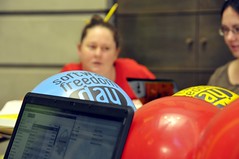An old friend of mine from the UK, Steve Usher, has pretty much nailed things with this blog on “Enthusing teen minds: Why today’s computers won’t create tomorrow’s programmers“. He says:
The computers of the early 80s were a blank canvas. You plugged them in, switched them on and (hopefully) the input cursor blinked at you. There was no decoration, no clutter and it was something waiting for YOU to do something to it.
Ah yes, I remember those days, when 3.5KB was a lot of memory! But what about today’s computers ?
They’re immediately brimming full of functionality all vying for your attention, but it’s also incredibly locked down. You can do absolutely anything… ANYTHING as long as it’s what the visionary who steered the programming teams thinks that you should want to do. Woe betide you if you want to do anything different. It’ll either ignore you or give you an unhelpful suggestion in a dialog box. You can be creative, but only in the ways you’re told you can be.
But before us free software types get all puffy and “I told you so”, he points out that things aren’t that much better on our systems with all our SDK’s, IDE’s, toolkits, compilers and interpreters:
It’s like taking a 5 year old into an engineering workshop, sitting him down and then complaining when he doesn’t build a car as he had all the tools available to him to do it and hence it must be his fault.
I’m not as sure that we need to build something new from scratch though, I think it might be more the case that what we need to do is to sort through all the various projects that could fit what he is after and build a distro (of whatever OS) that boots up straight into that application and lets them play with it. Perhaps something like SDLbasic (a BASIC interpreter for game development) might be a good start ?



